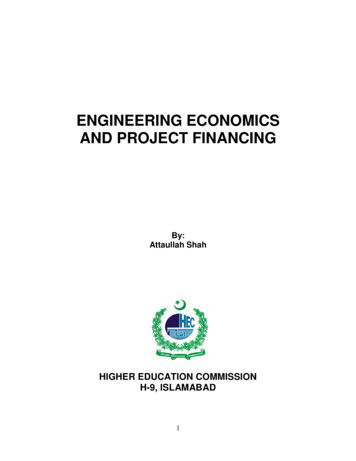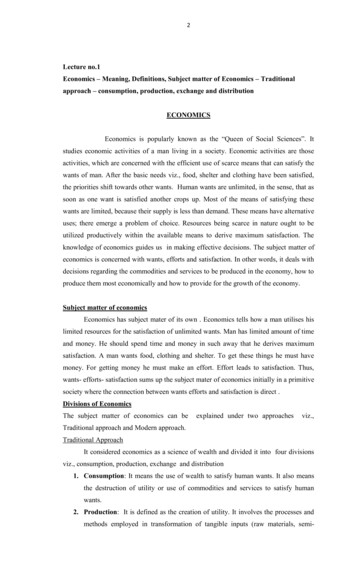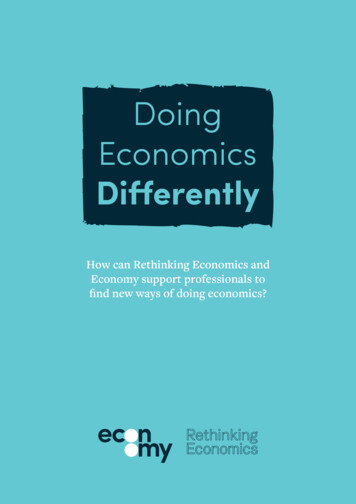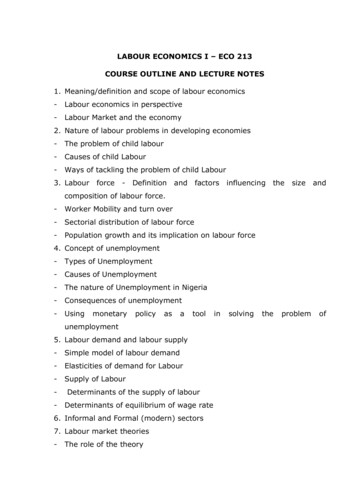
Transcription
E NGINEERING E CONOMICS AND F INANCIALM ANAGEMENTC HAN D UONG N GUYENAalborg University
The School of Engineering and ScienceStudy Board of Civil EngineeringThomas Manns Vej 239220 Aalborg ØPhone 99 40 84 84http://www.civil.aau.dkProject title:Engineering Economics andFinancial ManagementTime period:1st of Februaryto 15st JuneParticipants:Chan Duong NguyenSupervisor(s):Lene Faber UssingReport pages: 25Completed: 15/06 - 2018Synopsis:When engineering is considered, it is usually thetechnical aspect that is associated with engineering.However, engineering also consists of the economicaland financial aspect, as a construction project take basisin economy and financing through a client.This report take basis in three main chapters. Chapter 2gives and understanding of the overall macroeconomicsand microeconomics, which can influence the buildingindustry. Important elements within these have beenemphasised, as these two areas are very broad. A briefoverview of the phases in the building industry is alsocovered.Through chapter 3 it is possible to assess how theeconomic planning for a construction project is carriedout. This consist of how cost for a project is estimated,how time affect money, and how different decisions aremade with basis in income or probability.Chapter 4 covers elements within accounting throughassets, liability, and the double entry book keeping.These overall make is possible to determine revenueand expenses, where the profit for the specified periodcan be deduced. Further, depreciation with threedifferent methods is outlined.In the discussion it is suggested to implement valueengineering, as it can affect the project positively.With basis in these three main areas, it is possible toget a general understanding of how the economicalperspective for engineers is perceived and performed.
PrefaceThis project is completed during the 10th semester by Chan D. Nguyen in the Project Management inthe Building Industry master programme. The project is within the topic Engineering Economics andFinancial Management, and contains a basic insight into the economical as well as financial aspect ofthe building industry.The project takes basis in a course offered on University of New South Wales located in Australia onsemester 2 in 2017. Knowledge and arguments are therefore with relation to what have been presentedthrough lectures, course literature, and lecturer Steven Davis.AcknowledgementsDuring the process of the project work I have received guidance from the supervisor Lene Faber Ussing,whom I would like to address my gratitude. She has showed commitment and support for the topic,which I really have appreciated.ParticipantsChan Duong NguyenSignature:v
ParticipantsAalborg UniversityResuméNår ingeniørarbejde betragtes, er det almindeligvis det tekniske aspekt, der er forbundet medingeniørarbejde. Dog dækker ingeniørarbejde ligeledes det økonomiske og finansielle aspekt, dakonstruktionsprojekter tager udgangspunkt i økonomi og finansiering gennem en klient.Denne rapport tager basis i tre hovedkapitler. Kapitel 2 giver en forståelse af den overordnede makro- ogmikroøkonomi, som kan påvirke byggebranchen. Vigtige elementer inden for disse er blevet fremhævet,da disse to områder er meget brede. En let gennemgang af faserne i byggebranchen er ligeledes dækket.Gennem kapitel 3 er det muligt at evaluere, hvordan den økonomiske planlægning for et konstruktionsprojekt er udført. Dette omhandler, hvordan omkostninger for et projekt estimeres, hvordan tidenpåvirker penge, samt hvordan forskellige beslutninger er taget med udgangspunkt med indkomst ogsandsynlighed.Kapitel 4 dækker elementer inden for regnskabsførelse gennem aktiver, passiver samt det dobbeltebogholderi. Dette giver overordnet mulighed for at bestemme omsætning og omkostninger, hvor profitfor en bestemt periode kan beregnes. Yderligere er afskrivning i form af tre metoder beskrevet.I diskussionen er det anbefalet at implementere value engineering, da det can påvirke projektet positivt.Ud fra de tre hovedområder er det muligt at få en general forståelse for hvordan det økonomiskeperspektiv for ingeniører er opfattet samt udført.vii
Table of contentsPrefaceAcknowledgements . . . . . . . . . . . . . . . . . . . . . . . . . . . . . . . . . . . . . . . .Participants . . . . . . . . . . . . . . . . . . . . . . . . . . . . . . . . . . . . . . . . . . . .vvvChapter 11IntroductionChapter 2 Macroeconomics and microeconomics2.1 Macroeconomics . . . . . . . . . . . . . .2.1.1 Output and GDP . . . . . . . . . .2.1.2 Fiscal policy and monetary policy .2.2 Microeconomics . . . . . . . . . . . . . .2.2.1 Blue Ocean Strategy . . . . . . . .2.2.2 FIFO vs LIFO . . . . . . . . . . .2.2.3 Price discrimination . . . . . . . .2.3 Phases in the building industry . . . . . . apter 5 Discussion5.1 Value Engineering . . . . . . . . . . . . . . . . . . . . . . . . . . . . . . . . . . . . . .2323Bibliography25I Appendix27Appendix A Cost Benefit Ratio29Appendix B Internal Rate of Return31.Chapter 3 Economic planning3.1 Cost estimation . . . . . . . . . . . . . . . .3.1.1 Work Breakdown Structure (WBS) .3.1.2 Factors to consider in estimating . . .3.2 The time value of money . . . . . . . . . . .3.2.1 Discounting and compounding . . . .3.2.2 Determining discount rate . . . . . .3.3 Project appraisal . . . . . . . . . . . . . . . .3.3.1 Benefit cost ratio . . . . . . . . . . .3.3.2 Net Present Value (NPV) . . . . . . .3.3.3 Internal Rate of Return (IRR) . . . .3.3.4 Risk and uncertainty . . . . . . . . .3.3.5 Decision making based on probability3.4 Continuous evaluation . . . . . . . . . . . .Chapter 4 Accounting4.1 Balance sheet . . . . . . . . . . .4.1.1 Double entry book keeping4.1.2 Revenue vs. expenses . .4.2 Depreciation . . . . . . . . . . . .ix
Group PON103-1.119Table of contentsAppendix C Monte Carlo Simulation33Appendix D Depreciation35x
1IntroductionEngineering economics is all about determining if engineering projects are worth carrying out. Thisin other words entails the question, will the benefits outweigh the costs? One of the biggest issues forengineering projects is the costs are usually incurred almost immediately, while the benefits might takea long time to occur, which can take decades. Engineering projects are therefore long term investments,which must be assessed in great detail, before they are initiated in physical form. However, long terminvestments hold different difficulties, which must be taking into account.The long term investments is complicated by the fact people have a high tendency of valuing objects inthe future with less worth than the value of the same objects at present time. Future value is thereforeperceived with less worth than the current value. The cost and benefits consequently need to be adjustedto account for this. Another issue is the uncertainty of the future. There are many unknown factors thatare difficult to predict, as the exact weather forecast, possible production errors, delays, budget overrun,etc. The expected outcome of the investment may thereby entail a smaller amount of benefits or maybecome obsolete. This can however also go the other way around, where the benefits are bigger thanexpected and produce an increased amount of benefits.An understanding of accounting for better manage of the financial aspect in projects and basicseconomics are therefore required, to be able to understand the different elements that can influence anengineering project. Furthermore, it gives an insight to the wider picture and how the different elementsfit together within engineering economics and financial management.1
2Macroeconomicsnomicsandmicroeco-In this chapter the overall macroeconomics is outlined. Important aspects have been emphasises, whichcan influence the economic perspective of different companies in the building industry. Microeconomicsis also covered, where the focus is on individual companies to how they their decisions affect utilisationand distribution of resources. Relevant areas are also described within Microeconomics. The differentconstruction phases as well as the financial planning in these are also accounted for.2.1MacroeconomicsBefore diving into specific economical aspects in the building industry such as economy planning,accounting, etc., which in general is focused on individual companies, the overall picture of economymust be understood through macroeconomics. Macroeconomics is a system of the overall performanceof the national and global economies. This covers a broad field of areas, where some key areas withinmacroeconomics will be accounted for. These areas are therefore external factors, which can influencethe building industry to for instance how projects are financed.2.1.1Output and GDPOne very important aspect of the overall national economy is output and GDP. Output is the amount ofeconomic goods an economy produces, meaning a higher output provide more goods and services for thepeople to enjoy. Following the higher output more labour is required resulting to a lower unemployment,which will create an economic growth. Economic growth is the main focus for many countries, as it notonly will increase stability in one country but can also affect the global perspective. Economic growth iscaused by five main factors, which is the overall focus: Improvement in the labour forceImprovement in the capital stockIncreases in natural resources (e.g. mineral, oil)Improvements in efficiencyImprovements in technologyGrowth is part of a business cycle, which can have three scenarios. Periods with high growth is referred asexpansions, low growth is referred as downturns, and periods of negative growth is referred as recessions.In relation to output, when the economy is expanding the businesses will in general produce at full output,where a need for new factories and capital goods may be necessary. When the growth is slowed downthe businesses are no longer producing at full output, where people can lose jobs and have less income.Focusing on stabilising and smoothing the growth is therefore critical.Output is measured in Gross Domestic Product (GDP), which is the total value of all the final goodsproduced for sale to the market value in an economy for a period (quarterly or yearly). The market valueis determined through an aggregate demand and aggregate supply. Many aspects must be considered forthe GDP, for instance are raw materials not considered final goods, as they would be double countedwhen produced into a product. Due to GDP being a monetary measure, it holds many deviation, whichdoes not show the correct picture of a society. This can be the distribution of income, unaccounted value3
Group PON103-1.1192. Macroeconomics and microeconomicsof work like household, etc. The output is often broken down to the formula given in Eq. 2.1.Y C G I X MYCGIXM(2.1)OutputConsumption by consumersConsumption by governmentInvestment by businessExport to other countriesImport from other countriesBy using Eq. 2.1 it is possible to understand fiscal policy, which gives the understanding of how tax caninfluence the output.2.1.2Fiscal policy and monetary policyFiscal policy is the use of fluctuation of government spending and taxation to influence the overalleconomy. If the government collects more taxes than it spends it is in surplus, and if it spends more thancollected tax it is in deficit. By using fiscal policy it is possible to influence the growth of the country.By this Eq. 2.1 is assessed. If the government increases the taxes, the consumption of consumers, C, willdecrease, and if the government spends the same amount the consumption of the government, G, willincrease. By this the output, Y , will not change. However, if the government increases their spendingto for instance big infrastructural projects without increasing tax, the output will increase, which willcreate growth. For this growth there is a potential multiplier effect. As the output is increased dueincreased government spending, more people will have jobs, meaning the consumption by consumers, C,will increase as well, and even further increase the output. Increasing spending by government is moreused by traditionally democratic governments than reducing the taxes. However, if the desired outcomeis not fulfilled it will lead to an increasing debt.This can in some extent be connected to monetary policy, as monetary policy is the control of moneysupply to influence the economy. If the money supply is increased people will have more money tospend, which will increase the aggregate demand and therefore increase the output and the general pricelevel. As described earlier, increasing the output will reduce unemployment. However, instead of thegovernment controlling it, central banks make the actions. These actions can be modifying the interestrate, inflation rate, changing the bank reserves, etc., which therefore focus on price stability with basis inmonetary supply.Before being able to use for instance fiscal policy it must be recognised by the government first. This iscalled lags, which can be inside lag and outside lag. Inside lag is the time it takes for a government toidentify a change to the economy, and then respond to it through for instance fiscal policy, while outsidelag is the time between the response and an actual effect to the economy. In relation to fiscal policy theinside lag tends be long, as the government has to do internal debates and discussions about the changes.However, if it is initiated the outside lag tends to be short, because changing tax rates and governmentalspending have an immediate effect. For monetary policy the inside lag tends to be short, because thecentral banks can make actions fast, while outside lags tends to be longer as for instance interest ratesaffect investment decisions. Fiscal policy and monetary policy therefore are a matter of balance to beable to keep a stable economy.4
2.2. Microeconomics2.2Aalborg UniversityMicroeconomicsFor the microeconomics the individual companies will be assessed to how, they can affect prices on themarket and why they can compete better compared to other competitors. Microeconomics shows howand why different goods have different value, even though the goods as final product is almost the same.Goods and services is based of four aspects. Land: Refers to any kind of natural resource. Labour: The physical and mental efforts of people, but it depends on the quality of labour in formof human capital. Human capital is the knowledge and skills the labour possess. Capital: Buildings, equipments, plant, etc. to ake to goods and services. Entrepreneurship: The human resource that organises the other three aspects.These four aspects is the basis of how the goods and services are created. One aspect itself can changethe quality of the final product, which will have more value for a consumer. Different companies can bythis choose what they want to invest into to be able to obtain a competitive advantage over other rivalson the market. However, this only concerns similar goods and services. If they choose to make a productnot similar to others, the consumer may tend to buy that product or not at all. The different choicestherefore hold different possibilities. In general, companies are only able to focus on some aspects due toscarcity of resources. A traditional example is a production between guns and butter. If a company putsmore effort into making guns, there will be put less effort into making butter. The same thought concernsmass production versus not mass production. If a company only produce a small number of guns andbigger amount of butter, better quality resource is used for the small amount which in this case are theguns. Overall, many economic theories is based on competition. It is therefore in this case assumedthat the amount produced is small compared to the whole industry. The maximum output of a firm’sproduction must also be taking into account, as they are restricted by the numbers and capabilities of thefirm. Therefore they must focus on other aspects to get consumers. Relevant for this is the use of blueocean strategy.2.2.1Blue Ocean StrategyBlue ocean strategy overall describes how different markets depends on the market concentration. If themarket concentration is high, it has many competitors fighting for the same consumers. A market like thisis referred as a red ocean. They then "win" these consumers by for instance marketing or investing moreinto the four aspects. By this a consumer may choose goods if for instance the natural resources are betterquality. However, it is suggested through the strategy to not invest into market with high concentration.The companies must identify blue oceans, which are markets with little or almost no competition. Inthese markets it is not needed to fight for the consumers, which will generate a lot of profit. Blue oceanstrategy is just one of many strategies that can be used for competitive advantage.In continuation of blue ocean strategy, the blue oceans tend to have monopoly. This means a singlefirm can influence the price of its goods by varying the quantity produced. Producing less intentionallycan therefore increase profit. These firms have high market power, as they have the ability to increaseproduct price without losing their consumers. Monopoly is caused by for instance a new market, patents,copyright, barriers to entry if compared to Porter’s five forces, branding, etc. In case of red oceansmonopoly would not exist. For instance an increase in price of a product a company produces withoutgood justification for the consumer, the consumer would just go to other competitors.5
Group PON103-1.1192.2.22. Macroeconomics and microeconomicsFIFO vs LIFOWhen the different products are produced the producer can choose two methods for inventorymanagement.FIFO is first in first out. It implies that the goods that were produced first are used first. Thus the cost ofgoods sold uses the earlier prices, and the value of current inventory uses the more recent prices.LIFO is last in first out. It implies that the goods that were produced latest are used first. Thus the valueof current inventory uses the earlier prices and the cost of goods sold uses the more recent prices.FIFO is advantageous to the company when costs are decreasing, as the first product sold are the mostexpensive. This means the cost of goods in increased, why you report fewer profit and therefore pay lesstax. LIFO is advantageous when costs are increasing, where the same apply. Some jurisdictions will notallow the use of LIFO. Where it is allowed businesses must choose one method and stick to it for allstocks and all years.2.2.3Price discriminationBesides focusing on different markets other factors can influence the price of goods. It has already beendescribed briefly, but will be clarified even further. Alternatively creating products with different basissuch as quality can influence the price. Some elements will be outlined: Reliability, e.g. thermostat accuracyCapacity, e.g. memory of computerPleasantness, e.g. high service level (waiter)Convenience, e.g. couponsQuantity, e.g. bulk discountChannel, e.g. internet vs. physical shopGeography, e.g. supermarket locationsAdd-ons, e.g. internet access at hotelsDelivery, e.g. hard cover vs. paperback booksThese are just some elements that can affect the price. Many more exist, which the different companiesuse at their disposal to get more consumers. These elements can also be transferred to the buildingindustry, where choosing for instance a sub-contractor with more reliability would be relevant.2.3Phases in the building industryThe macroeconomics has a great effect on the building industry, as it is external factors influencingpotential investments into construction projects both private and governmental. The microeconomicsgive an insight to how, competition in not only the building industry is formed. To be able to understandthe specific economical aspects in the building industry the lifecycle of phases a construction project passthrough is described. In the construction industry a project is defined by objectives, starting and finishpoints clarified by the developer. These phases will be described with the focus of an overall financialmanagement and are illustrated in Figure 2.1.Initiation and concept phaseGenerating relevant information in this phase is essential, as it will determine if the project is into interestor not. Based on the information a cost benefit analysis can be carried out to be able to evaluate the project6
2.3. Phases in the building industryAalborg UniversityFig. 2.1: Phases for a construction project.feasibility. This is also the phase where it is easiest and most inexpensive to make changes to the project,if for instance a reduced cost or increased value is desired.Planning and development phaseIn this phase a detailed plan and design are performed for the project. The financial planning includedefining budget for different elements in the project, and refining them continuously when moreinformation is available. Different options will also be assessed, which will have a major role in selection.Implementation phaseWithin the implementation phase the actual work is performed, which is the major work. The financialaspect will be continuous evaluation of information regarding money spent in comparison with budgets,as well as forecasts remaining costs. Depending on this information it is possible to identify, if anythingneeds to be revised such as the planned project work in order to keep the project within budget.Delivery or termination phaseThis is the final stage of the construction project, where the the phase overall concerns the handover ofproducts to the client. An error and defect assessment by both the client and contractors are carried out.If both parties accept, the project will be handed over. The last financial management will be finalisingthe project review of the cost outcomes, where improvements, etc. are evaluated for future projects.With basis in the different phases, it is possible to understand the deeper level for economics. This isoutlined in Chap. 3, where a more profound assessment of the financial aspect is described.7
3Economic planningIn this chapter the preliminary work for initiating a construction project is accounted for. This includehow cost is estimated, the time value of money that changes over time, and the external factors affectingthe financial management. How decision making with basis in income or probability is also covered.3.1Cost estimationWhen an organisation or government chooses to initiate a construction project, they usually expect tohave more benefits than actual cost, or else there would be no purpose of carrying out the project. Tobe able to evaluate this it is necessary to estimate what benefits will accrue from it as well as the actualcosts. However, these estimates depend on the extent and detail of data at disposal for the organisation.The more and detailed the data is, the more accurate the estimates will be. Often in the earliest stagesof a construction project the estimates are not very accurate as the information at disposal is limited.Some of the first cost estimations are done in the two first phases illustrated in Figure 2.1, which itthe procurement phase. Developing information consist of costs for the organisation and developinggood information for the estimates can be beneficial, and even approximate estimates may be useful forthe decision-making to for instance whether extra initiatives, which may be more costly, can be carriedout. In contradictory, developing information based on limited data can give a false future prediction ofthe actual scenario, why a fine balance must be taking into account. Naturally, as the project developsthrough the procurement phases of a construction project more information is also developed, whereestimates become more accurate. The different phases describes the procurement phase as illustrated inFigure 3.1, where the approximate standard deviation development also are shown.Fig. 3.1: Standard deviation development through procurement phases.The different phases of the procurement phase will be accounted for.9
Group PON103-1.1193. Economic planningOrder of magnitude magnitudes estimatesThe first initiatives when a project is commenced to establish the broad viability of the overall project,which in other words is the first budget for the fiscal planning. Fiscal planning can be understood as afinancial business plan in accordance to a fiscal financial year to for instance the annual tax return. Thisis not calculated in the traditional calendar year that starts on the first of January. Estimates in the stageis usually based on previous experience with similar projects.Preliminary estimatesThis phase is performed when some information on the project has been developed to be able tomore accurately determine the extent of the overall financial commitment. It is also done to evaluatealternatives.definitive estimatesThis is the process of the detailed design phase, to ensure that the cost of the structure or facilitydeveloping from the design process is within budget. If there is a risk of a budget overrun, the probabilityof that risk must be determined as well as the extent.Detailed estimatesThe last phase of the process of preparing a tender for the construction project, where a creation of adetailed work plan is finalised.3.1.1Work Breakdown Structure (WBS)The procurement phases described overall is the phases different companies go through when forminga tender. However, all companies have their own systems and phases they go through when forming atender. The described one is therefore just an example. Making a tender is easier said than done, wheremany different methods can be used as a system. A widely used system in the building industry is WorkBreakdown Structure (WBS) formed in the mid 1960’s originally for the U.S. Department of Defence.WBS is a hierarchical decomposition of a construction project, where any significant project can bebroken down into several sub-projects. A fundamental comprehension is the 100 % rule. If one elementis divided into smaller sub-projects, those sub-projects in total define the divided element 100 %, whichapplies to all levels. Therefore, those sub-projects can be divided even further if needed. [Fried et al.,2011] The breakdown of sub-projects is generally divided into individual activities or tasks. The lowestlevel must consist of a delegation of time, cost, and resources to the individual activities, tasks, so theresponsibilities can be assigned. The lowest level must also be manageable and measurable. If this isnot possible the elements must be broken down further. The levels can be infinite, however the levelsnormally range from 2 to 5. To be able to determine the number of levels, different aspects must betaking into consideration: [Haugan, 2002] Size and complexityStructure of the organisations involvedPhase of the projectDegree of uncertainty and risksTime available for planningAn illustration of the overall basis of WBS with 4 levels is illustrated in Figure 3.2.10
3.1. Cost estimationAalborg UniversityFig. 3.2: The basis of WBS.Cost Breakdown Structure (CBS)The WBS can also be translated into Cost Breakdown Structure (CBS), which overall is the same asWBS. The differences is that the activities are broken down into smaller cost groups with different costcode. Each cost code can for instance refer to materials, labour, equipment, etc.3.1.2Factors to consider in estimatingWhen a system has been set for the estimation such as WBS, there are different factors that must betaking into account when carrying out the estimation. These will be accounted forHazards and local factorsThis overall concerns a risk management study of how to identify risks, analyse and evaluate risks, andwhat action that must be taking to deal with the risk. Risks could for instance be availability of labourand materials, weather, fire, flood, etc.Productivity factorsFor this a plan for how to sustain an acceptable productivity with focus on facility management must becarried out. This therefore concerns the following, plant and equipment: AgeLocation of projectSkill of operator, e.g. truck driverMaintenance program before and/or under breakdownLabour: Environment on and around project, e.g. temperatureJob situation, e.g. work in high altitudeWorking hoursLearning curves11
Group PON103-1.1193. Economic planningThe mentioned learning curves within labour is important to understand, why this will be accounted forin more detail.Learning curvesLearning curves is basically about, the more an activity is performed and repeated, the more efficientthe workers become, which result the work being done in progressively less time and lower cost [Peck,1984]. The learning curves are defined through Eq. 3.1 and Eq. 3.2.kT̄nTnT̄n T1 · klog2 n(3.1)Tn T1 · [nklog2 n (n 1)klog2 (n 1) ](3.2)Improvement factorAverage man hours, unit after n cyclesMan hours, unit for the nth cycleThe smaller the factor k is, the faster the workers learn. On average it is around 0.8, but can range from0.65 to 0.95. This means, if the
the Building Industry master programme. The project is within the topic Engineering Economics and Financial Management, and contains a basic insight into the economical as well as financial aspect of the building industry. The project takes basis in a course offered on University of New South Wales located in Australia on semester 2 in 2017.











